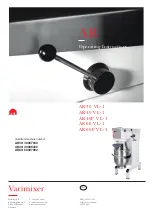
15
28. MAIN/AUX 1 EQ SWITCH
This switch allows you to add EQ either to
your main mix, or to your monitors.
In the UP (MAIN) position, the EQ (27)
only affects the main mix, phone or tape outs.
In the DOWN (AUX 1) position, the EQ only
affects the AUX SEND 1/MON (7) output; with
no effect on the main mix, phone or tape outs.
29. BYPASS EQ SWITCH
Use this switch to quickly compare the
effect of your EQ settings.
In the UP position, the EQ (27) section is
in line with the signal path, (either main mix
or monitor, depending on the position of the
MAIN/AUX 1 (28) switch).
In the DOWN position, the EQ section is by-
passed and has no effect on any outputs.
30. POWER LED
This LED turns on when the mixer is
switched on, and (as you can probably guess)
it turns off when the mixer is switched off.
31. PHANTOM POWER SWITCH and LED
Press this switch to turn on the pretty LED.
It also supplies phantom power to all of the
mono channels’ XLR MIC inputs. Phantom
power is required to operate most condenser
microphones (some condenser microphones
are battery-powered). With the switch pressed
in, the DFX Mixers p48 VDC phantom
powering on pins 2 and 3 of the XLR connectors.
Note:
The stereo channels do not have
phantom power on their XLR connectors.
If you have dynamic, ribbon, or tube mics
that do not require phantom power, leave the
switch out. If you are using both condenser and
dynamic mics, don’t worry. Phantom power will
not hurt most dynamic mics. Check the
microphone’s user manual if you’re not sure.
Caution:
Turn all output
levels down before operat-
ing this switch to avoid the
possibility of a “pop” in your
speakers.
32. METERS
The DFX Mixer’s metering system is made
up of two columns of twelve LEDs each, with
thresholds ranging from –30 dB up to “CLIP.”
The 0 dB LEDs correspond to an output
level of +4 dBu (=1.23 V). The “CLIP” LEDs
turn on when the output r20 dBu.
There is a fair margin of safety before actual
clipping distortion occurs, but you should turn
things down if you see it come on.
The meters display the level of the main
mix, after the MAIN MIX (34) faders.
You can get a good mix with the meter’s
peaks flashing anywhere between –20 and
+8 dB. Most amplifiers clip at about +10 dB,
and some recorders aren’t so forgiving either.
For best real-world results, try to keep your
peaks between “0” and “+8.”
If your meters are too high, you will get dis-
tortion. If they are too low, then your signal/
noise will suffer. Use the meters to help you
adjust the mixer for optimum performance
without distortion or noise, then you can
adjust your amplifiers for good overall volume.
33. PHONES
This control allows you to adjust the head-
phone levels without disturbing the main mix.
Turn this down before connecting and put-
ting on your headphones. Bring it up slowly.
Please see the “Safety Instructions” on page
2 for information on hearing protection.
34. MAIN MIX FADERS
These two faders control the final level of
the signals sent to the MAIN (5) outputs.
The TAPE (12) and PHONE (6) outputs
also receive the main mix, but are not affected
by these faders.
All active mono and stereo channels that
are not turned fully down will appear in the
main mix. Other signals feeding these faders
include: AUX 1 RETURN(9), AUX 2 RETURN
(10) including the EMAC internal effects, and
the CD/TAPE (11) inputs.
The faders, set fully up, provide 10 dB of
gain. A “U” unity gain point is just below that.
When set fully down, the main mix is effec-
tively muted. These are the faders to pull
down at the end of the song when you want
The Great Fade-Out.
35. CD/TAPE RETURN FADER and MUTE
If you have a CD or Tape player connected to
the CD/TAPE (11) inputs, the signals pass through
the MUTE switch, through this stereo fader, and
then into your main mix. This is like a channel
fader, except it is adding the CD/TAPE input to
the main mix, instead of adding a channel.
Set this fader to minimum, then play your
selection and increase the fader as desired.
Assuming the MAIN MIX (34) faders are set,
you should hear the music. Press down the
VOCAL ELIMINATOR (37) if you like to
remove centered vocals, and BREAK (36) if
you want to play soothing CDs or tapes
while the band is breaking up the bar.










































